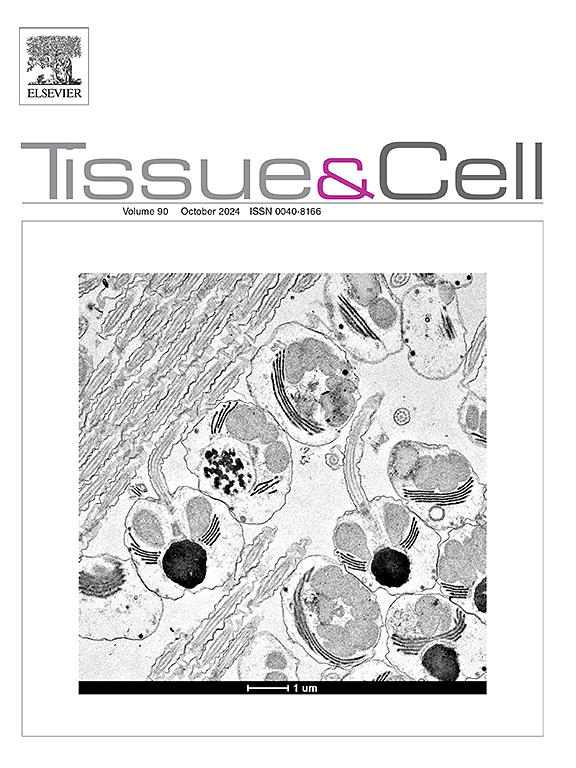Effects of Agastache foeniculum essential oil on skin wound healing in mice
IF 2.7
4区 生物学
Q1 ANATOMY & MORPHOLOGY
引用次数: 0
Abstract
Chronic wounds are frequently hindered by high levels of reactive oxygen species, which perpetuate inflammation and delay healing. Antioxidants could mitigate oxidative stress and promote wound repair. This study investigates effectiveness of Agastache foeniculum essential oil in promoting skin wound healing. Thirty-six mice were divided into three groups: Sham (SH), Soybean oil (SB), and Agastache foeniculum (AGS), with each group split into excisional and incisional wounds. Treatments were applied topically for nine days. Wound contraction was measured on days 0, 3, 6, 9, 12, and 14 using ImageJ software. On day 10, biomechanical properties were assessed. Biochemical parameters, including Total Antioxidant Capacity (TAC), Total Oxidant Status (TOS), Malondialdehyde (MDA), and Glutathione Peroxidase (GPx), were evaluated on days 7 and 14. Additionally, hydroxyproline levels, Western blot analyses for TNF-α and NF-κB, and histopathological examinations were conducted. The AGS group showed a significant reduction in wound area on days 3, 9, 12, and 14. Increased strain (85.97 %), ultimate strength (9.52 N), and energy storage (13.14 J) was observed in the AGS group compared to controls. MDA levels were significantly lower (0.39, 0.36 nmol/mg protein), and TAC was significantly higher (1.68, 1.8 nmol/mg protein) in the AGS group on both days 7 and 14. Hydroxyproline levels were elevated (90.55 mg/g), and TNF-α was reduced in the AGS group, while NF-κB levels showed a non-significant decrease. Histopathological analysis indicated reduced inflammation and enhanced tissue remodeling in AGS-treated wounds. These findings suggest that Agastache foeniculum essential oil effectively promotes skin wound healing by enhancing contraction, strengthening biomechanical properties, reducing oxidative stress, and modulating inflammation, highlighting its potential as a therapeutic agent in wound management. Also one limitation of this study is the lack of gene expression of the markers.
小茴香精油对小鼠皮肤创面愈合的影响
慢性伤口经常受到高水平活性氧的阻碍,这会使炎症持续并延迟愈合。抗氧化剂可以减轻氧化应激,促进伤口修复。本研究探讨小茴香精油对皮肤创面愈合的促进作用。将36只小鼠分为假药组(SH)、大豆油组(SB)和小拇指组(AGS),每组分为切除和切口创面。局部治疗9天。使用ImageJ软件于第0、3、6、9、12、14天测量创面收缩。第10天,评估生物力学性能。在第7天和第14天测定各组小鼠的生化指标,包括总抗氧化能力(TAC)、总氧化状态(TOS)、丙二醛(MDA)和谷胱甘肽过氧化物酶(GPx)。此外,还进行了羟脯氨酸水平、TNF-α和NF-κB的Western blot分析和组织病理学检查。AGS组在第3、9、12、14天伤口面积显著减少。与对照组相比,AGS组的应变(85.97 %)、极限强度(9.52 N)和能量储存(13.14 J)均有所增加。在第7天和第14天,AGS组MDA水平显著降低(0.39、0.36 nmol/mg蛋白),TAC水平显著升高(1.68、1.8 nmol/mg蛋白)。AGS组羟脯氨酸水平升高(90.55 mg/g), TNF-α水平降低,NF-κB水平无明显降低。组织病理学分析显示ags治疗的伤口炎症减轻,组织重塑增强。这些发现表明,小茴香精油通过增强皮肤收缩、增强生物力学性能、减少氧化应激和调节炎症,有效地促进皮肤伤口愈合,突出了其作为伤口治疗药物的潜力。本研究的另一个局限性是缺乏标记的基因表达。
本文章由计算机程序翻译,如有差异,请以英文原文为准。
求助全文
约1分钟内获得全文
求助全文
来源期刊

Tissue & cell
医学-解剖学与形态学
CiteScore
3.90
自引率
0.00%
发文量
234
期刊介绍:
Tissue and Cell is devoted to original research on the organization of cells, subcellular and extracellular components at all levels, including the grouping and interrelations of cells in tissues and organs. The journal encourages submission of ultrastructural studies that provide novel insights into structure, function and physiology of cells and tissues, in health and disease. Bioengineering and stem cells studies focused on the description of morphological and/or histological data are also welcomed.
Studies investigating the effect of compounds and/or substances on structure of cells and tissues are generally outside the scope of this journal. For consideration, studies should contain a clear rationale on the use of (a) given substance(s), have a compelling morphological and structural focus and present novel incremental findings from previous literature.
 求助内容:
求助内容: 应助结果提醒方式:
应助结果提醒方式:


